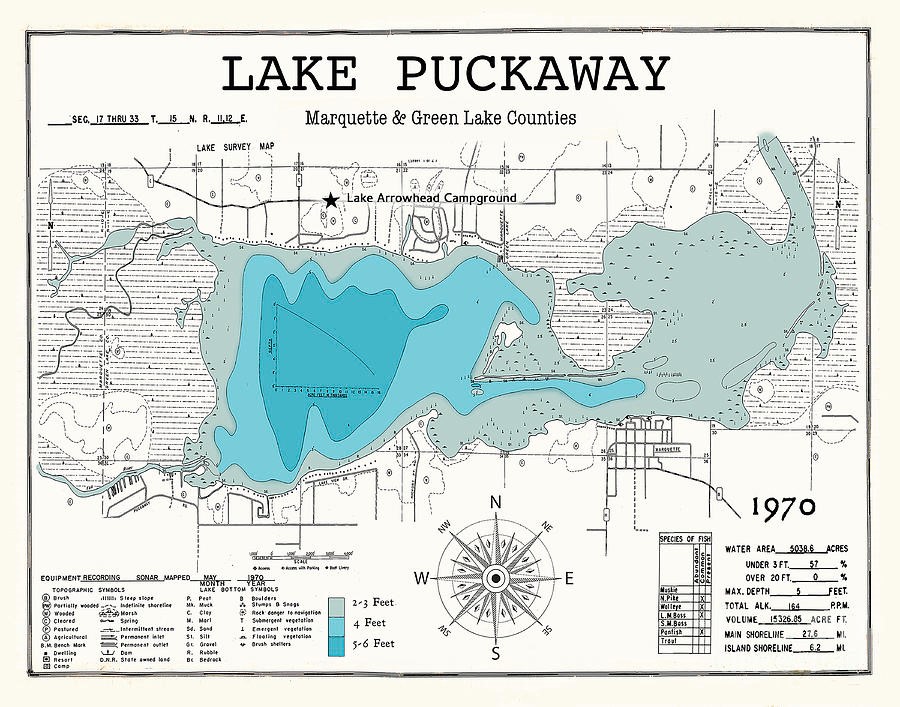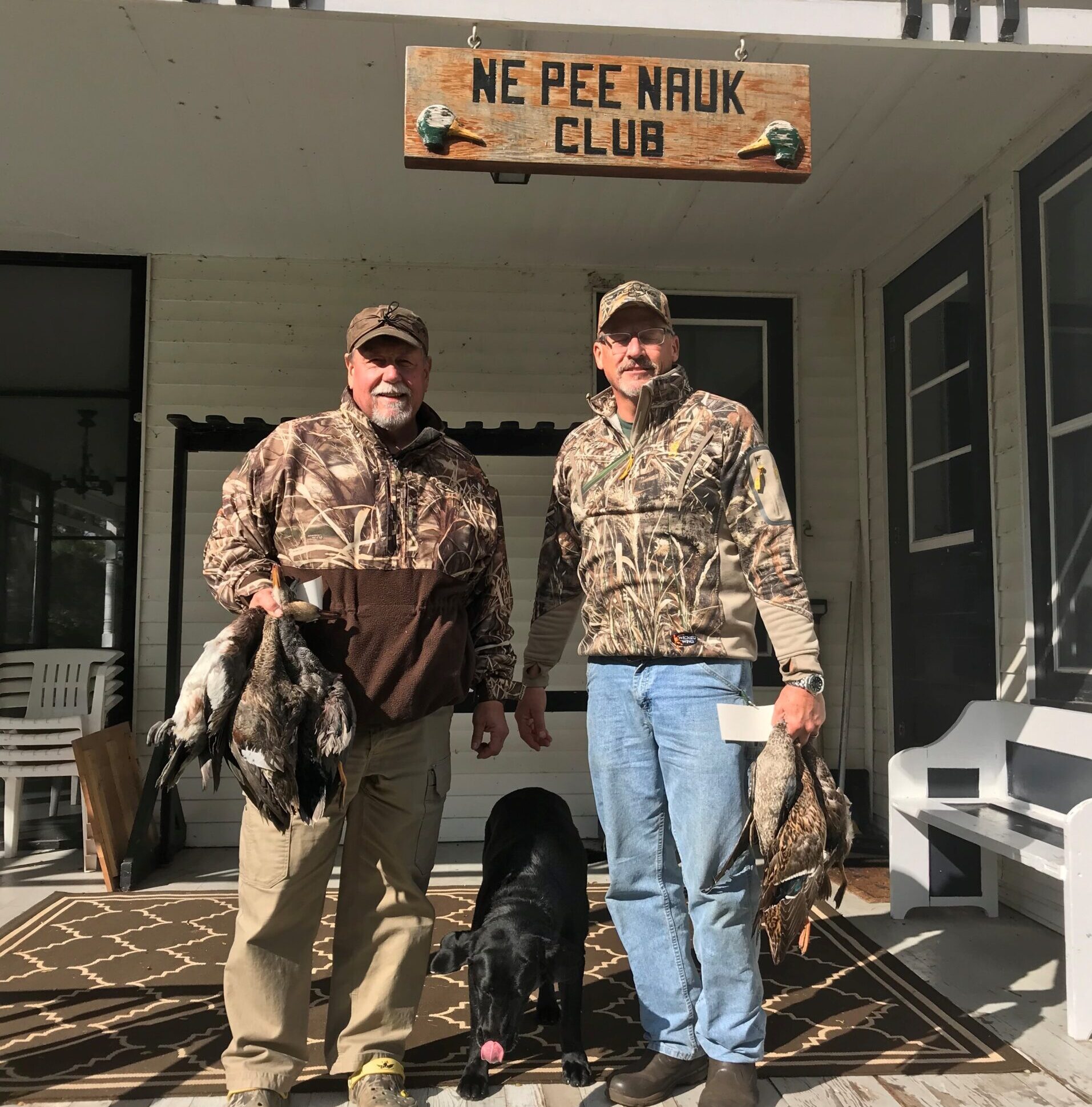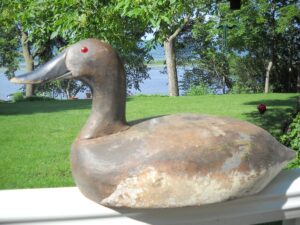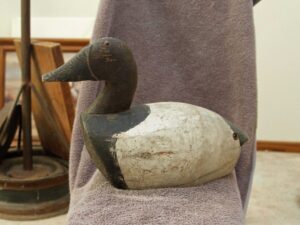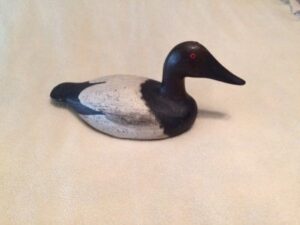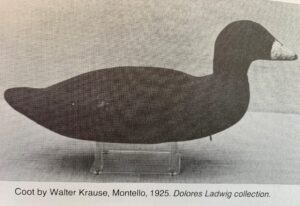A Decoy Corner Article
By Bruce Urben, WWA President
First, a little history on Lake Puckaway and its development as a waterfowling hotbed: Lake Puckaway is located in Green Lake and Marquette counties in Central Wisconsin. The Fox River flows through the lake and the lake level is controlled by a dam situated at the east end. The lake is approximately 5400 acres in size, six and a half miles long and two miles wide with a maximum depth of six feet. Water quality in the lake began deteriorating in the late 1950’s. Earlier, large beds of wild celery and wild rice embodied much of the lake. Lake Puckaway was gradually going through “eutrophication” where sediments and other deposits slowly fill the lakebed. The cause points to the Fox River, which flows through the lake, and ice age melts of the past. In the late 1800’s the original winding Fox River that empties into the lake was re-routed and straightened to discharge near the southwest corner of the lake. This was to better facilitate steamboat passage from Oshkosh. The original winding discharge area was renamed as the “dead river”.
Considering the access provided through steamships, a rich lake with wild rice and wild celery, Lake Puckaway was a waterfowl hotbed for migrating ducks and geese each fall!
The Zellmer family migrated to Lake Puckaway in the 1860’s from Germany. They purchased, and eventually developed, thousands of acres of marsh on the northwest end of Puckaway and provided rooms and guides for waterfowlers from all over the Midwest.
In the 1870’s, Martin Zellmer sold land on the lake to a group of Chicago businessmen who formed the original property holding of the “Ne Pee Nauk” Duck Club. Reportedly, the property was sold for $10 and a bottle of whiskey! These Chicago businessmen built an 18 room lodge in 1882. In the 1880’s Native Americans were still settled in the area because of the prime hunting and fishing opportunities. It is said that “Ne Pee Nauk” is translated from Indian language meaning “Place on the Knoll”. Currently the “Ne Pee Nauk duck club is one of the oldest established duck clubs in the State of Wisconsin that is still active!
While the waterfowl hunting was superb on Lake Puckaway, so were area resident decoy carvers. Many of the areas carvers hunted Puckaway and provided decoys for the many local duck clubs. Quite a few of the carvers on Puckaway used the same style in their carved decoys. Sturdily made, compact, solid wood decoys with a simple paint pattern and a head with glass eyes. Early on, diver ducks were the prominent species being carved, including canvasbacks, redheads, scaup and coots! Puddle duck decoys became more prominent in the ’50’s and the ’60’s while the lake was becoming degraded in water quality.
At least 16 decoy carvers lived and carved in the Lake Puckaway area and I will briefly try to describe each with a short history and summary of their work. Be sure to check in for next months conclusion to “Lake Puckaway Decoy Carvers”.
Frank Ambrosich
Frank was born in 1880 and came to the Montello area from Minnesota in the 1920’s. He was employed as a designer and carver at the Montello granite quarry. He carved canvasbacks and bluebills with perky heads, blended paint patterns and most have a painted speculum. All decoys were used and sold on Lake Puckaway. Frank passed away in 1941.
Art Bliefnick
Art was born in 1904 and lived on his farm near Lake Puckaway. His decoys were very crude, as they were made exclusively with hand tools. His heads look as though they were just placed on top of the body and the breast runs flat up to the head. He carved canvasbacks and coots. His decoys were boldly painted with no blending or feathering. Art passed away in 1973 in Princeton.
Paul Buchen
Paul was born in 1885. He started carving in 1919 and continued for over 20 years. He worked as a ticket agent at the railroad depot in Montello. Paul carved several hundred canvasback and bluebill decoys. They were used and sold to area hunters on Puckaway. His decoys had rough sawn bodies, simple paint and a head with glass eyes. Paul passed away in 1958.
Paul Doering
Please see previous Decoy Corner article “Paul Doering – Duckman of Princeton“.
Harold Giese
Harold was born in 1908 and lived in the Princeton area. He was employed as a lumberman and ran a lumber yard in Princeton. Harold carved dozens of decoys from 1945-1965 and used them exclusively on Lake Puckaway. Most of his decoys were made of black cork with crude heads. He is best known for his unique wood, floating silhouette decoys made from two pieces of one inch pine boards. Harold passed away in Princeton in 1970.
August “Gus” Hellar
August was born in 1901 and lived in Montello. He started his carving career In 1930 and continued through the 1940’s. His style was similar to most Puckaway carvers, however he had a lot of detail carved into his heads. It is reported that he carved over 100 decoys . Gus passed away in 1984.
Walter was born in 1918 and owned Krause’s Resort on Lake Puckaway. He carved approximately 300 decoys through the 1940’s. Walter carved mostly canvasbacks as well as coots and bluebills. His decoys are sleek and low in the Puckaway style. He sold very few of his decoys, most were used himself or given away to his hunting friends or customers at his resort. Walter passed away in 1987 in Montello.
Hubert Kurkowski
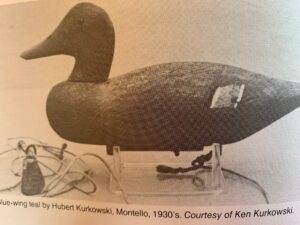 Hubert was born in 1907 and lived in Montello. He was employed as a lock tender on the Fox River for over 20 years. Hubert carved dozens of mallard and teal decoys for his own hunting rigs. His decoys are slim, solid wood and well built with eye catching paint patterns. All his heads had glass eyes and all of his decoys were used on Lake Puckaway. Hubert passed his carving and waterfowl hunting passion on to his son Ken, who is still carving. Hubert passed away in 1985.
Hubert was born in 1907 and lived in Montello. He was employed as a lock tender on the Fox River for over 20 years. Hubert carved dozens of mallard and teal decoys for his own hunting rigs. His decoys are slim, solid wood and well built with eye catching paint patterns. All his heads had glass eyes and all of his decoys were used on Lake Puckaway. Hubert passed his carving and waterfowl hunting passion on to his son Ken, who is still carving. Hubert passed away in 1985.
Stay tuned for Part II coming in December…

